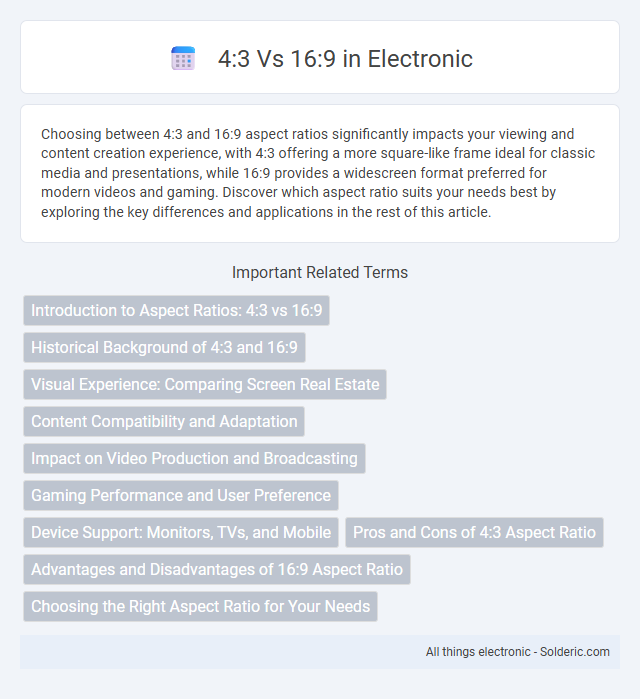Choosing between 4:3 and 16:9 aspect ratios significantly impacts your viewing and content creation experience, with 4:3 offering a more square-like frame ideal for classic media and presentations, while 16:9 provides a widescreen format preferred for modern videos and gaming. Discover which aspect ratio suits your needs best by exploring the key differences and applications in the rest of this article.
Comparison Table
| Aspect Ratio | Description | Resolution Examples | Common Usage | Advantages | Disadvantages |
|---|---|---|---|---|---|
| 4:3 | Traditional standard aspect ratio; more square-shaped | 1024x768, 800x600 | Older TVs, computer monitors, presentations | Better for documents and older media; less letterboxing on older content | Narrower view; less suited for widescreen video and modern displays |
| 16:9 | Widescreen standard aspect ratio; wider screen | 1920x1080 (Full HD), 1280x720 (HD) | Modern TVs, computer monitors, smartphones, video content | Ideal for HD video, cinematic content; wider field of view | Letterboxing or pillarboxing when displaying 4:3 content |
Introduction to Aspect Ratios: 4:3 vs 16:9
The 4:3 aspect ratio, once standard for televisions and monitors, offers a nearly square display that suits older content and certain professional applications like video conferencing. The 16:9 aspect ratio, now dominant in HDTVs, smartphones, and modern monitors, provides a widescreen experience ideal for cinematic viewing and gaming. Choosing between these ratios depends on your content type and device compatibility, with 16:9 delivering a more immersive, contemporary visual experience.
Historical Background of 4:3 and 16:9
The 4:3 aspect ratio originated from early film and television standards, established during the 1930s with the Academy Ratio widely used in cinema and standard-definition TV broadcasts. As widescreen films grew in popularity in the 1950s, the 16:9 aspect ratio was introduced and later adopted as the global standard for high-definition television and digital displays to accommodate cinematic presentation and broader viewing experiences. The shift from 4:3 to 16:9 reflects technological advancements and changes in content consumption, emphasizing immersive and widescreen formats.
Visual Experience: Comparing Screen Real Estate
The 16:9 aspect ratio offers more screen real estate horizontally, enhancing your visual experience with wider, more immersive content ideal for movies and gaming. The 4:3 ratio, narrower and taller, provides a more squared display that is beneficial for classic content and productivity tasks requiring vertical space. Choosing between 4:3 and 16:9 directly affects how much of the image you see and how natural the viewing feels depending on the media format.
Content Compatibility and Adaptation
The 4:3 aspect ratio remains ideal for older television broadcasts, classic films, and certain video game formats, ensuring compatibility with legacy content without distortion. The 16:9 aspect ratio is widely adopted for modern HD and UHD content, offering a wider field of view that matches most current media and streaming platforms. Content adaptation between these ratios often involves letterboxing or cropping, which can affect the visual integrity and user experience depending on the display device.
Impact on Video Production and Broadcasting
The 16:9 aspect ratio has become the industry standard in video production and broadcasting due to its compatibility with high-definition formats and widescreen displays, enabling more immersive viewer experiences. The 4:3 aspect ratio, once dominant in standard definition television, limits framing options and visual storytelling, often requiring letterboxing or cropping when displayed on modern screens. Adopting 16:9 streamlines content delivery across various platforms, including streaming services and digital broadcasts, optimizing video quality and audience engagement.
Gaming Performance and User Preference
The 16:9 aspect ratio dominates modern gaming due to its wider field of view and compatibility with most games, enhancing immersion and situational awareness. In contrast, the 4:3 aspect ratio offers a more condensed field of view, which some gamers prefer for competitive play because it can reduce peripheral distractions and increase frame rates on older hardware. User preference varies, with casual gamers favoring 16:9 for cinematic experiences while eSports players may lean towards 4:3 for precision and performance optimization.
Device Support: Monitors, TVs, and Mobile
The 4:3 aspect ratio remains prevalent in older monitors and legacy mobile devices, providing a squarer display ideal for reading and certain professional applications. In contrast, 16:9 dominates modern TVs, most computer monitors, and smartphones, offering a widescreen experience that enhances video playback and gaming visuals. Your choice between these ratios should consider device compatibility and content type to optimize viewing comfort and performance.
Pros and Cons of 4:3 Aspect Ratio
The 4:3 aspect ratio offers a more square-shaped display ideal for older content and certain professional uses, providing better vertical space for reading and editing documents. However, it shows black bars or cropped images on modern widescreen monitors and HDTVs, limiting its compatibility with current video formats. Your choice depends on whether you prioritize classic content display or modern widescreen experiences.
Advantages and Disadvantages of 16:9 Aspect Ratio
The 16:9 aspect ratio offers a wider field of view, enhancing the cinematic experience and making it ideal for modern HDTVs, computer monitors, and gaming. However, its wider format can lead to letterboxing or black bars when displaying content originally created in narrower ratios like 4:3, resulting in unused screen space. Your choice of aspect ratio should consider the type of content you primarily consume, as 16:9 delivers superior compatibility for widescreen media but may compromise legacy 4:3 visuals.
Choosing the Right Aspect Ratio for Your Needs
When choosing the right aspect ratio for your needs, consider that 4:3 offers a more square image ideal for older content, presentations, and documents, while 16:9 is the industry standard for widescreen displays, HD video, and gaming. Your decision should be influenced by the type of media you consume or create, as 16:9 delivers a wider field of view and better suits modern devices like TVs, monitors, and smartphones. Selecting the appropriate aspect ratio ensures optimal display quality and compatibility with your preferred devices and content formats.
4:3 vs 16:9 Infographic

 solderic.com
solderic.com